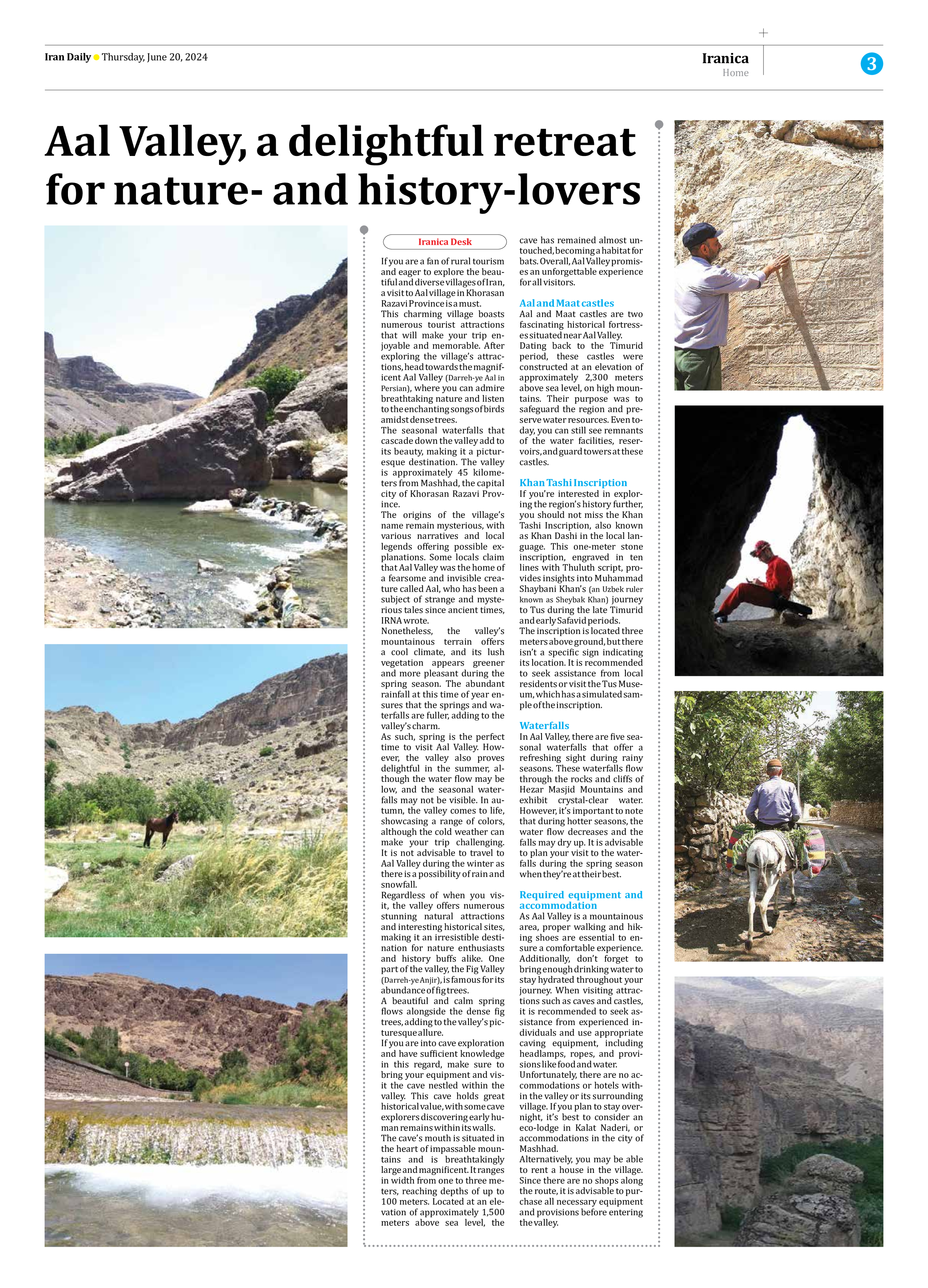
Aal Valley, a delightful retreat for nature- and history-lovers
If you are a fan of rural tourism and eager to explore the beautiful and diverse villages of Iran, a visit to Aal village in Khorasan Razavi Province is a must.
This charming village boasts numerous tourist attractions that will make your trip enjoyable and memorable. After exploring the village’s attractions, head towards the magnificent Aal Valley (Darreh-ye Aal in Persian), where you can admire breathtaking nature and listen to the enchanting songs of birds amidst dense trees.
The seasonal waterfalls that cascade down the valley add to its beauty, making it a picturesque destination. The valley is approximately 45 kilometers from Mashhad, the capital city of Khorasan Razavi Province.
The origins of the village’s name remain mysterious, with various narratives and local legends offering possible explanations. Some locals claim that Aal Valley was the home of a fearsome and invisible creature called Aal, who has been a subject of strange and mysterious tales since ancient times, IRNA wrote.
Nonetheless, the valley’s mountainous terrain offers a cool climate, and its lush vegetation appears greener and more pleasant during the spring season. The abundant rainfall at this time of year ensures that the springs and waterfalls are fuller, adding to the valley’s charm.
As such, spring is the perfect time to visit Aal Valley. However, the valley also proves delightful in the summer, although the water flow may be low, and the seasonal waterfalls may not be visible. In autumn, the valley comes to life, showcasing a range of colors, although the cold weather can make your trip challenging. It is not advisable to travel to Aal Valley during the winter as there is a possibility of rain and snowfall.
Regardless of when you visit, the valley offers numerous stunning natural attractions and interesting historical sites, making it an irresistible destination for nature enthusiasts and history buffs alike. One part of the valley, the Fig Valley (Darreh-ye Anjir), is famous for its abundance of fig trees.
A beautiful and calm spring flows alongside the dense fig trees, adding to the valley’s picturesque allure.
If you are into cave exploration and have sufficient knowledge in this regard, make sure to bring your equipment and visit the cave nestled within the valley. This cave holds great historical value, with some cave explorers discovering early human remains within its walls.
The cave’s mouth is situated in the heart of impassable mountains and is breathtakingly large and magnificent. It ranges in width from one to three meters, reaching depths of up to 100 meters. Located at an elevation of approximately 1,500 meters above sea level, the cave has remained almost untouched, becoming a habitat for bats. Overall, Aal Valley promises an unforgettable experience for all visitors.
Aal and Maat castles
Aal and Maat castles are two fascinating historical fortresses situated near Aal Valley.
Dating back to the Timurid period, these castles were constructed at an elevation of approximately 2,300 meters above sea level, on high mountains. Their purpose was to safeguard the region and preserve water resources. Even today, you can still see remnants of the water facilities, reservoirs, and guard towers at these castles.
Khan Tashi Inscription
If you’re interested in exploring the region’s history further, you should not miss the Khan Tashi Inscription, also known as Khan Dashi in the local language. This one-meter stone inscription, engraved in ten lines with Thuluth script, provides insights into Muhammad Shaybani Khan’s (an Uzbek ruler known as Sheybak Khan) journey to Tus during the late Timurid and early Safavid periods.
The inscription is located three meters above ground, but there isn’t a specific sign indicating its location. It is recommended to seek assistance from local residents or visit the Tus Museum, which has a simulated sample of the inscription.
Waterfalls
In Aal Valley, there are five seasonal waterfalls that offer a refreshing sight during rainy seasons. These waterfalls flow through the rocks and cliffs of Hezar Masjid Mountains and exhibit crystal-clear water. However, it’s important to note that during hotter seasons, the water flow decreases and the falls may dry up. It is advisable to plan your visit to the waterfalls during the spring season when they’re at their best.
Required equipment and accommodation
As Aal Valley is a mountainous area, proper walking and hiking shoes are essential to ensure a comfortable experience. Additionally, don’t forget to bring enough drinking water to stay hydrated throughout your journey. When visiting attractions such as caves and castles, it is recommended to seek assistance from experienced individuals and use appropriate caving equipment, including headlamps, ropes, and provisions like food and water.
Unfortunately, there are no accommodations or hotels within the valley or its surrounding village. If you plan to stay overnight, it’s best to consider an eco-lodge in Kalat Naderi, or accommodations in the city of Mashhad.
Alternatively, you may be able to rent a house in the village. Since there are no shops along the route, it is advisable to purchase all necessary equipment and provisions before entering the valley.







